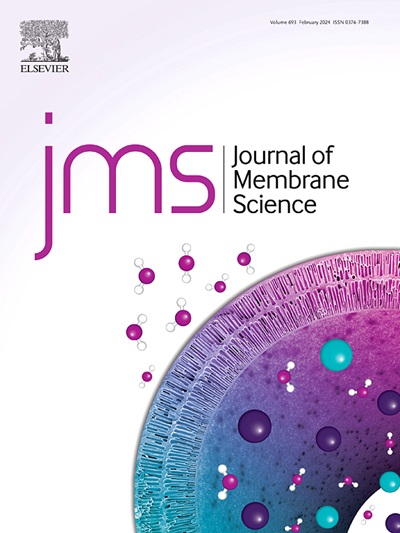Semifluorinated polymer membranes by ring-opening metathesis polymerization during spin coating
IF 9
1区 工程技术
Q1 ENGINEERING, CHEMICAL
引用次数: 0
Abstract
Membrane technologies can offer dramatically higher energy efficiency than thermally driven separations such as distillation. The fabrication of robust, solvent-stable active layers on inexpensive supports is essential for the widespread utilization of this technology by industry. Here we show that polymer membranes incorporating a perfluoroalkyl side chain onto a hydrocarbon backbone provide remarkable enhancements in performance and stability in the dehydration of ethanol by pervaporation, even surpassing commercial perfluoropolymers. To rapidly generate these robust thin film composite membranes, we use a method termed spin coating ring-opening metathesis polymerization (scROMP) that combines the polymerization and deposition of the membrane selective layer into a 2-min process with under 1 mL of solvent per 36 cm2 of polymer. Here, the scROMP of 5-(perfluoro-n-alkyl)norbornenes (NBFn) with perfluoroalkyl side chain lengths (n) of 4, 6, 8, and 10 is used to generate semifluorinated films on polyacrylonitrile (PAN) supports. pNBFn membranes exhibit greater solvent stability than their nonfluorinated polynorbornene (pNB; n = 0) counterpart while retaining excellent thermal stability, as evidenced by reduced swelling in polar and nonpolar solvents and <1 % mass loss in thermogravimetric analysis up to 130 °C. Molecular simulations show that the fluorocarbon side chains orient parallel to the surface in the bulk but more normal to the surface at the interface, consistent with experimental IR spectroscopy and wetting measurements. Of the polymers studied, pNBF8 shows the greatest performance in ethanol dehydration, obtaining a selectivity of 180 and a water permeance of 1000 GPU, while sustaining high performance for >40 h of continuous operation.

旋涂开环复聚半氟化聚合物膜
膜技术可以提供比蒸馏等热驱动分离技术高得多的能源效率。在廉价的支架上制造坚固、溶剂稳定的活性层对于该技术在工业上的广泛应用至关重要。本研究表明,将全氟烷基侧链结合到碳氢化合物主链上的聚合物膜在通过渗透蒸发脱水乙醇时的性能和稳定性显著增强,甚至超过了商用全氟聚合物。为了快速生成这些坚固的薄膜复合膜,我们使用了一种称为自旋涂层开环复分解聚合(scROMP)的方法,该方法将聚合和膜选择层的沉积结合到一个2分钟的过程中,每36平方厘米的聚合物使用不到1毫升的溶剂。在这里,全氟烷基侧链长度(n)为4,6,8和10的5-(全氟-n-烷基)降冰片烯(NBFn)的scrmp用于在聚丙烯腈(PAN)载体上生成半氟化薄膜。pNBFn膜比其非氟化聚降冰片烯(pNB;n = 0),同时保持优异的热稳定性,在极性和非极性溶剂中减少溶胀,在高达130°C的热重分析中质量损失<; 1%。分子模拟表明,氟碳侧链在体中平行于表面,但在界面处更垂直于表面,与实验红外光谱和润湿测量结果一致。在所研究的聚合物中,pNBF8在乙醇脱水中表现出最好的性能,选择性为180,透水性为1000 GPU,并且在连续运行>;40 h时保持高性能。
本文章由计算机程序翻译,如有差异,请以英文原文为准。
求助全文
约1分钟内获得全文
求助全文
来源期刊

Journal of Membrane Science
工程技术-高分子科学
CiteScore
17.10
自引率
17.90%
发文量
1031
审稿时长
2.5 months
期刊介绍:
The Journal of Membrane Science is a publication that focuses on membrane systems and is aimed at academic and industrial chemists, chemical engineers, materials scientists, and membranologists. It publishes original research and reviews on various aspects of membrane transport, membrane formation/structure, fouling, module/process design, and processes/applications. The journal primarily focuses on the structure, function, and performance of non-biological membranes but also includes papers that relate to biological membranes. The Journal of Membrane Science publishes Full Text Papers, State-of-the-Art Reviews, Letters to the Editor, and Perspectives.
 求助内容:
求助内容: 应助结果提醒方式:
应助结果提醒方式:


